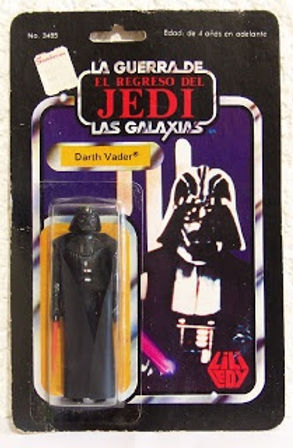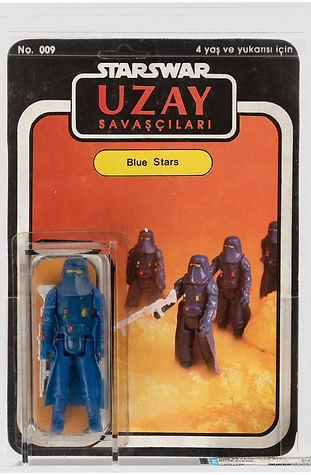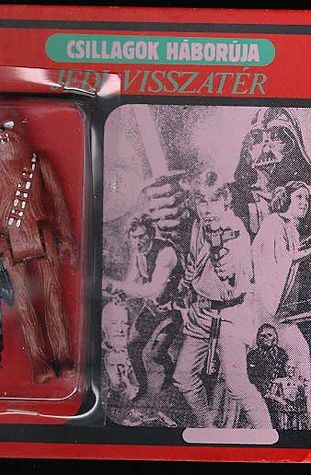🌍 Notable Bootleg Figure Lines by Region
While Kenner defined the official Star Wars action figure legacy, the galaxy is much bigger than what was licensed. Across Eastern Europe, Latin America, Asia, and beyond, bootleg Star Wars figures emerged—unauthorized, often bizarre, and now highly collectible. These off-brand versions were usually created out of necessity, limited access, or pure opportunism during the toy craze of the late '70s and '80s.
Today, bootlegs are no longer seen as cheap knockoffs—they're unique artifacts of global Star Wars fandom, often harder to find than their licensed counterparts.
💡 Why Bootlegs Matter to Collectors
Bootleg figures:
-
Offer a unique look into how global markets interpreted Star Wars.
-
Are often far rarer than Kenner originals—sometimes made in runs of a few hundred.
-
Are each piece of toy art history—especially those with crude molds, odd paint jobs, or bootleg-only sculpts.
🔍 What to Look For
-
Material: Bootlegs are often made from soft rubber, brittle plastic, or resin.
-
Paint & Sculpt: Look for unrefined or wildly colored paint apps.
-
Packaging: Most came loose, but some have bootleg cardbacks that are now highly collectible.
-
Provenance: Figures from Eastern Europe, Latin America, and Asia are especially desirable.
-
Rarity: Some bootlegs (like Uzay’s “Blue Stars”) can sell for over $10,000 if complete and in great condition.

🇲🇽 Mexico – Lili Ledy Bootlegs & Beyond
-
While Lili Ledy was officially licensed, other lesser-known Mexican companies created unlicensed bootlegs, sometimes copying Ledy molds.
-
Bootlegs often used bright, non-screen-accurate colors, fragile plastics, and crude accessories.
-
Popular bootlegs: “Super Amigos”-style figures, brightly painted Darth Vaders and Stormtroopers.

🇹🇷 Turkey – Uzay
-
The Uzay figures from Turkey (often grouped with Eastern European bootlegs) are legendary among collectors.
-
Famous for absurd packaging (e.g., Star Wars Vader with a photo of a Battlestar Galactica ship) and renamed characters (e.g., “Head Man”).
-
Most sought-after: Blue Stars (blue Hoth Stormtrooper) and Head Man—rare and worth thousands.

🇵🇱 Poland – Articulated & Solid Limbed Figures
-
Polish bootlegs came in two main types: solid plastic (unarticulated) and articulated figures with removable limbs.
-
Many came unpainted or partially painted, often with vibrant colors.
-
Notable for hand-cast rubber or resin molds and odd proportions.
-
Favorites: Polish Boba Fett and C-3PO bootlegs with bright metallics.

🇧🇷 Brazil – Glasslite Bootlegs
-
Glasslite made licensed Star Wars figures in Brazil, but many unlicensed versions followed.
-
Bootlegs often used poorly detailed molds and unusual colors (e.g., yellow Vader capes or green R2 units).
-
Considered rare due to Brazil’s economic challenges and lower toy production numbers.

🇭🇺 Hungary – Rubber Mold Figures
-
These are small-run, handmade figures with thick rubbery textures and inconsistent paint apps.
-
Often sold in blister packs with hand-drawn or generic sci-fi cards.
-
Highly collectible for their primitive but charming aesthetic.

🇷🇺 Oritet– Plastic Mold Figures
-
Who / What Was Oritet
Oritet was a small toy factory based in or near St. Petersburg, Russia, active from the 1990s through the early 2000s. Known for producing fantasy toy figures, Oritet also created unlicensed Star Wars “bootleg” action figures that filled the gap left by limited official distribution from Kenner or Hasbro in Russia.
Timeline & Background
-
1990s → mid-2000s: Oritet produced 3.75-inch unlicensed Star Wars figures, both loose and carded.
-
1990s: Early runs included metallic or silver AT-AT Drivers and other odd paint variants.
-
2000s: Later years brought colorful versions like hot-pink or orange Bossk, gold Chewbacca, and carded Yoda releases.
-
After the owner’s passing, the company declined, shifting to simple plastic toys before closing. Some molds later surfaced under another Russian maker, Biplant.
Key Variants Collectors Watch For
-
AT-AT Driver (silver) — Distinct metallic finish, rare and sought after when carded.
-
Bossk (color variants) — Yellow, metallic green/orange, or even hot-pink; often with two weapon molds.
-
Chewbacca (gold/brown) — Kenner-scale with unique paint and sheen.
-
Yoda (carded/loose) — Carded examples command higher value.
-
Oddities — Unusual accessories, altered articulation, or factory sprue remnants.
-
Because Oritet’s output was unofficial and poorly documented, collector knowledge comes mostly from auctions and community research—making each surviving figure a quirky piece of Star Wars bootleg history.
